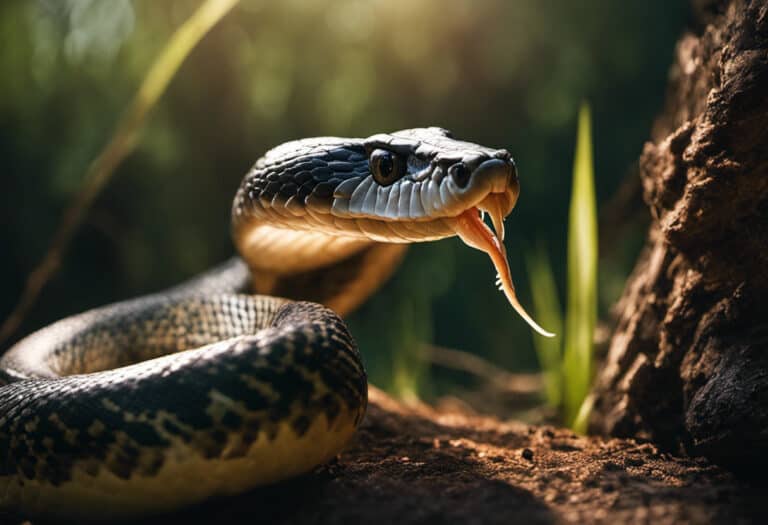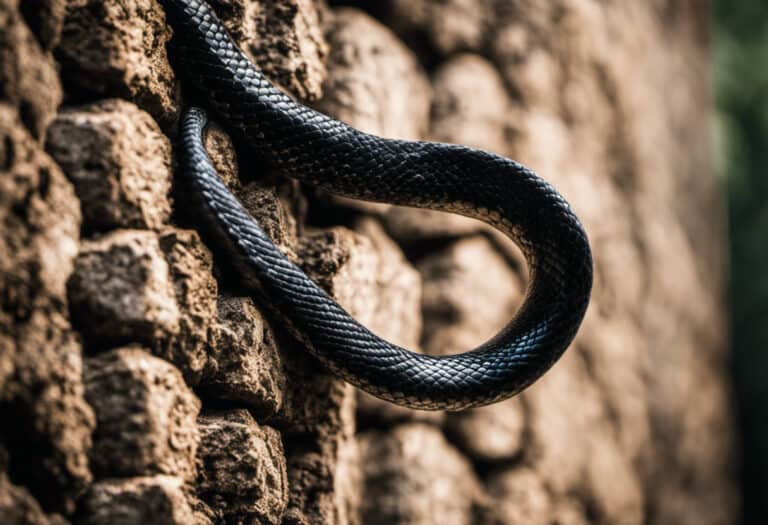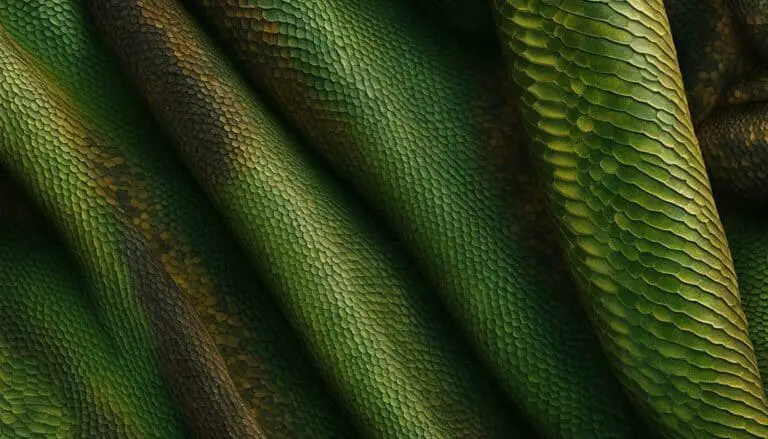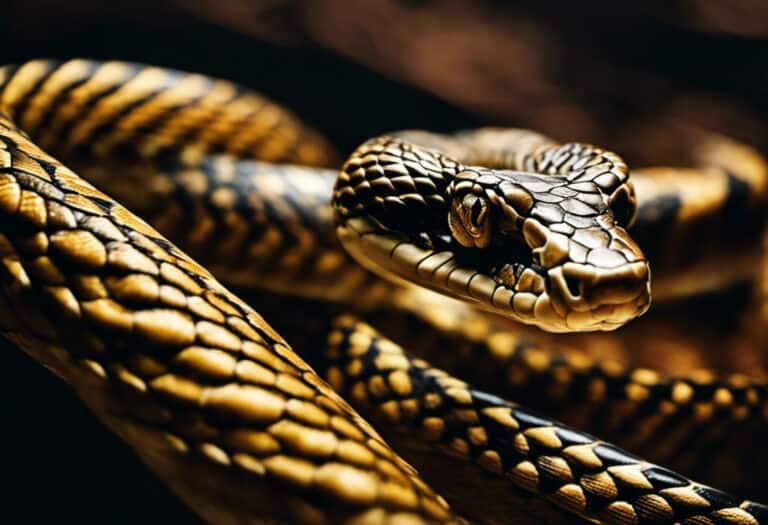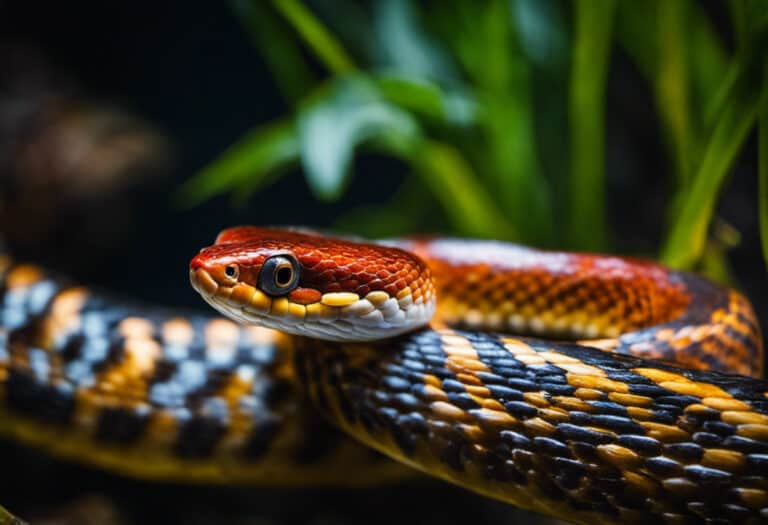How Do Snakes Build Their Homes?
Have you ever wondered how snakes, those fascinating creatures of the reptile world, build their homes?
Well, get ready to delve into the intriguing habits of these slithering creatures.
Out of over 3,000 snake species worldwide, only one stands out – the King cobra. Known for its exceptional nesting behavior, this snake constructs nests using leaves and weeds to protect its eggs.
But that’s not all; other snakes have their unique ways of ensuring their eggs and young are kept safe.
Join us as we explore the captivating world of snake nest-building.
Key Takeaways
- King cobras are the only snake species that build nests.
- Snakes choose safe locations for nesting to protect their eggs and young.
- King cobras use leaves to create nests and incubate their eggs.
- Snakes can also nest in houses for protection and security.
Unique Nesting Behaviors of Snakes
You may be surprised to learn that snakes have unique nesting behaviors. While the King cobra is the only species known to build nests, other snakes still ensure their eggs and young are kept in safe environments.
Snakes are particular about where they nest, choosing areas with loose and overgrown vegetation, animal burrows, decaying logs, or mounds of leaves.
However, it isn’t uncommon for snakes to nest in urban areas, including houses. They seek the comfort and security these structures provide, often choosing basements, laundry rooms, or other cool and dark areas.
Snakes have adapted to utilize these spaces to hide and protect their eggs or young.
Understanding snake nesting adaptations is important in preventing them from nesting in urban areas and ensuring the freedom and safety of both humans and snakes.
Choosing the Perfect Nesting Locations
When choosing a nesting location, snakes carefully select safe areas to protect their eggs and young from predators and egg hunters.
Snake nesting preferences can vary among different species, but they generally seek out locations that provide shelter and security.
Here is a table that showcases some of the nesting habits of different snake species:
| Snake Species | Nesting Habit |
|---|---|
| King Cobra | Builds nests using leaves and vegetation, incubates eggs on top of the nest for protection |
| Rat Snake | Nests in animal burrows, decaying logs, and mounds of leaves |
| Garter Snake | Nests in loose soil and sand, underground or beneath rocks |
| Rattlesnake | Nests in rocky crevices or under logs |
Understanding snake nesting preferences is crucial for ensuring their conservation and protecting their habitats.
By providing suitable nesting areas, we can help maintain the freedom and survival of these fascinating reptiles.
The Fascinating Nest-Building of King Cobras
You’ll be amazed at the fascinating nest-building behavior of King cobras. These majestic snakes use their heads to gather leaves, creating a carefully constructed nest.
They then lay their eggs in the nest, covering them with more leaves and weeds for protection.
This unique nesting behavior sets King cobras apart from other snake species and showcases their impressive maternal instincts.
King Cobra Nest Structure
The King cobra constructs its nest by gathering leaves and using its head to create a structure to lay its eggs in. This nesting behavior is unique to the King cobra species, as other snake species don’t exhibit this behavior.
Snakes that don’t nest still ensure that their eggs and young are kept in a safe environment. King cobras choose safe locations for their nests, such as loose and overgrown vegetation, animal holes, and underground in loose soil and sand. Other nesting places include animal burrows, decaying logs, and mounds of leaves.
Snakes can also nest in houses, as they provide protection and security. Preventing snakes from nesting in houses requires taking specific precautions.
Nesting Behavior Variations
If you come across a snake nest, it may vary in structure depending on the species and location. Snake nesting adaptations have evolved over time to ensure the safety and survival of their eggs and young.
The evolution of nesting behavior in snakes is fascinating and demonstrates their ability to adapt to different environments. Snakes have developed various strategies to protect their offspring, such as choosing safe locations and constructing nests.
Here is a table that illustrates some of the different nesting adaptations observed in snake species:
| Nesting Adaptation | Description |
|---|---|
| Burrowing | Some snakes dig burrows in the ground to create nests. These burrows provide protection from predators and maintain a stable temperature for the eggs. |
| Arboreal | Arboreal snakes, like tree boas, create nests in trees. They may coil their bodies around a branch to form a secure nest for their eggs. |
| Communal | Some snake species, such as garter snakes, exhibit communal nesting behavior. Multiple females may lay their eggs in the same nest, increasing the chances of survival for the offspring. |
| Camouflaged | Certain snake species, like rattlesnakes, construct nests that blend in with their surroundings. These camouflaged nests provide concealment and protection from predators. |
| Oviparous | Oviparous snakes lay eggs and rely on the nest as a safe environment for their developing offspring. They may use various materials, such as vegetation or soil, to create a nest structure. |
The evolution of snake nesting behavior showcases the remarkable adaptability of these reptiles.
Their nesting adaptations have allowed them to thrive in diverse habitats and ensure the survival of their young. By understanding these nesting behaviors, we can gain a deeper appreciation for the complexity and ingenuity of snake species.
Snakes Nesting in Unexpected Places: Inside Houses
Snakes may choose to nest in houses as they provide the comfort and safety they seek. Living in urban areas, they often find houses to be suitable nesting locations.
However, it’s important to take measures to snake-proof your home to ensure your freedom from these reptiles.
Here are some steps you can take:
- Seal any gaps or cracks in your house’s foundation and walls to prevent snakes from entering.
- Keep your yard well-maintained by trimming overgrown vegetation and removing debris, as snakes are attracted to such areas.
- Store firewood and other materials away from the house, as they can provide hiding spots for snakes.
- Install snake-proof mesh or fencing around your property to create a barrier that prevents snakes from entering.
Understanding Snake Diet, Venom, and Nocturnal Behavior
You can learn about snake diet, venom, and nocturnal behavior to better understand these fascinating creatures.
Snakes are carnivorous reptiles with a diverse diet consisting of rodents, birds, eggs, and small mammals. Some larger species can even consume prey as large as deer or pigs. Snakes have a unique ability to dislocate their jaws to swallow prey larger than their head.
Venomous snakes, such as the Inland Taipan, Eastern Brown Snake, Black Mamba, and King Cobra, possess specialized glands that produce venom. This venom is injected into their prey to immobilize or kill them. It can cause severe pain, tissue damage, and even death in humans. These venomous snakes have distinct fangs designed to inject venom.
Non-venomous snakes, on the other hand, lack venom-producing glands and typically have solid teeth for gripping and swallowing prey.
Snakes are also known for their nocturnal behavior, being most active during the night. Nocturnal snakes, like the Eastern Diamondback Rattlesnake and African Rock Python, have adaptations such as heat-sensing pits and excellent night vision to locate and hunt prey in the dark.
Understanding snake feeding habits and venomous adaptations is crucial in appreciating the complexity and survival strategies of these remarkable creatures.
Venomous Vs. Non-Venomous Snakes: Key Differences
When it comes to venomous versus non-venomous snakes, there are key differences that set them apart.
Venomous snakes, such as the Inland Taipan and the King Cobra, possess specialized glands that produce venom. They’ve distinct fangs designed to inject venom into their prey.
On the other hand, non-venomous snakes typically have solid teeth for gripping and swallowing prey.
Understanding these differences is crucial for identifying and handling snakes safely.
Fangs or Solid Teeth
If you encounter a snake with fangs, be cautious as it may be venomous. Venomous snakes possess specialized dental adaptations that allow them to inject venom into their prey. These adaptations include:
- Hollow Fangs: Venomous snakes have long, hollow fangs that are connected to venom glands. When the snake strikes, the fangs pierce the prey’s skin, allowing venom to be injected.
- Venom Glands: These specialized glands produce venom, a complex mixture of proteins and enzymes that immobilize or kill the snake’s prey.
- Venom-Neutralizing Enzymes: Snakes have evolved specific enzymes that neutralize the effects of their own venom, protecting them from self-harm.
- Solid Teeth: Non-venomous snakes typically have solid teeth for gripping and swallowing prey, lacking the specialized adaptations seen in venomous species.
Understanding these dental adaptations can help you distinguish between venomous and non-venomous snakes, giving you the freedom to make informed decisions when encountering these fascinating creatures.
Venom Effects on Organisms
Venomous snakes inject their prey with venom, which can cause severe pain, tissue damage, and even death in humans. The effects of venom on prey are both fascinating and terrifying.
Snake venom is a complex mixture of proteins and enzymes that have various effects on different organisms. Some venoms can paralyze the prey, while others cause internal bleeding or disrupt the nervous system. These adaptations in snake venom allow them to immobilize or kill their prey more efficiently.
Venomous snakes possess specialized glands that produce venom and distinct fangs designed to inject venom into their prey. These adaptations enable them to subdue their prey quickly and efficiently.
It’s essential to understand the effects of snake venom to protect ourselves and appreciate the incredible adaptations these snakes possess.
The Nocturnal World of Snakes: Hunting and Surviving in the Dark
As you explore the world of snakes, you’ll discover that many species have adapted to the dark and have developed exceptional night vision to hunt and survive. Here are some fascinating facts about snake hunting techniques and their adaptations for hunting at night:
- Snakes use a combination of their keen senses, such as their exceptional night vision, heat-sensing pits, and flicking tongues, to locate prey in the dark.
- Some snake species, like the Eastern Diamondback Rattlesnake and the African Rock Python, have specialized heat-sensing pits on their faces that allow them to detect the infrared radiation emitted by warm-blooded prey.
- Snakes rely on their stealth and patience to ambush their prey, striking with lightning speed and precision.
- Many nocturnal snakes have vertical slit-shaped pupils that can dilate to let in more light, enhancing their night vision.
These adaptations enable snakes to navigate and thrive in the darkness, showcasing their remarkable ability to adapt and survive in their natural environment.
Frequently Asked Questions
What Other Animals Besides Snakes Build Nests?
Birds and rodents are among the many animals that build nests. Nests provide a safe and secure environment for eggs and young. These structures are carefully constructed using materials like twigs, leaves, and grass.
How Do Snakes Choose the Specific Leaves and Weeds They Use to Build Their Nests?
When building their nests, snakes choose specific leaves and weeds based on their suitability for creating a safe and protective environment for their eggs or young. They carefully select materials that provide insulation, camouflage, and security.
Are There Any Specific Precautions Homeowners Can Take to Prevent Snakes From Nesting in Houses?
To prevent snake nesting in your home, take precautions like sealing gaps, installing door sweeps, and keeping the surroundings clean. Remove potential hiding spots and keep the area well-maintained. Snake proofing homes can help ensure a snake-free environment.
How Often Do Snakes Need to Eat in Order to Survive?
Snakes’ feeding habits vary, but they can go for weeks or even months without eating after a meal. The frequency of feeding is crucial for their survival, as they need to consume prey to obtain energy and nutrients.
What Are Some Examples of the Different Effects Snake Venom Can Have on Organisms?
Snake venom can have diverse effects on organisms. For instance, some venoms can cause paralysis, rendering their prey immobile. Others can cause tissue destruction, leading to severe damage. The effects of snake venom vary depending on the species.
Conclusion
In conclusion, snakes’ nesting behaviors and preferences vary across species, with the King cobra being the only known snake to build nests. They gather leaves with their heads and create safe environments for their eggs, providing protection and warmth.
Other snakes seek out safe locations such as animal burrows, decaying logs, or mounds of leaves. These fascinating creatures have adapted unique ways to ensure the safety of their offspring, just like a master architect skillfully constructs a sanctuary for their creations.
